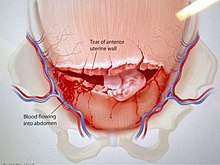Uterine rupture
| Uterine rupture | |
|---|---|
vaginal birth after cesarean section[1] | |

Uterine rupture is when the muscular wall of the uterus tears during pregnancy or childbirth.[3] Symptoms, while classically including increased pain, vaginal bleeding, or a change in contractions, are not always present.[1][2] Disability or death of the mother or baby may result.[1][3]
Risk factors include
Treatment involves rapid surgery to control bleeding and delivery of the baby.
Rates of uterine rupture during vaginal birth following one previous
Signs and symptoms
Symptoms of a rupture may be initially quite subtle. An old cesarean scar may undergo dehiscence; with further labor the woman may experience abdominal pain and vaginal bleeding, though these signs are difficult to distinguish from normal labor. Often a deterioration of the fetal heart rate is a leading sign, but the cardinal sign of uterine rupture is loss of fetal station on manual vaginal exam. Intra-abdominal bleeding can lead to hypovolemic shock and death. Although the associated maternal mortality is now less than one percent, the fetal mortality rate is between two and six percent when rupture occurs in the hospital.
In pregnancy uterine rupture may cause a viable abdominal pregnancy. This is what accounts for most abdominal pregnancy births.
- Abdominal pain and tenderness. The pain may not be severe; it may occur suddenly at the peak of a contraction. The woman may describe a feeling that something "gave way" or "ripped."
- Chest pain, pain between the scapulae, or pain on inspiration—Pain occurs because of the irritation of blood below the woman's diaphragm
- Hypovolemic shock caused by bleeding, evidenced by falling blood pressure, tachycardia, tachypnea, pallor, cool and clammy skin, and anxiety. The fall in blood pressure is often a late sign of haemorrhage
- Signs associated with fetal oxygenation, such as late deceleration, reduced variability, tachycardia, and bradycardia
- Absent fetal heart sounds with a large disruption of the placenta; absent fetal heart activity by ultrasound examination
- Cessation of uterine contractions
- Palpation of the fetus outside the uterus (usually occurs only with a large, complete rupture). The fetus is likely to be dead at this point.
- Signs of an abdominal pregnancy
- Post-term pregnancy
Risk factors
A uterine scar from a previous
Uterine rupture during pregnancy without a prior cesarean section is one of the major diagnostic criterion for vascular
Mechanism
In an incomplete rupture the
Treatment
Emergency exploratory laparotomy with cesarean delivery accompanied by fluid and blood transfusion are indicated for the management of uterine rupture. Depending on the nature of the rupture and the condition of the patient, the uterus may be either repaired or removed (cesarean hysterectomy). Delay in management places both mother and child at significant risk.
